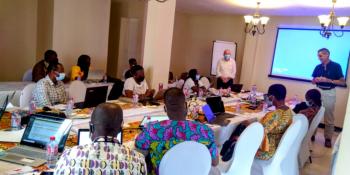Can we blame El Niño?

For years, people have been pointing to El Niño as the culprit behind floods, droughts, famines, economic failures, and record-breaking global heat. Can a single climate phenomenon really cause all these events?
Is the world just a step away from disaster when El Niño conditions develop? What exactly is this important climate phenomenon and why should society care about it? We address these questions as well as clear up some common misconceptions about El Niño, La Niña, and everything in between!
First, the basics. El Niño refers to the occasional warming of the eastern and central Pacific Ocean around the equator (see image). The warmer water tends to get only 1 to 3 degrees Celsius above the average sea-surface temperatures for that area, although in the very strong El Niño of 1997-98, it reached 5 degrees or more above average in some locations. La Niña is the climate counterpart to El Niño– a yin to its yang, so to speak. A La Niña is defined by cooler-than-normal sea-surface temperatures across much of the equatorial eastern and central Pacific. El Niño and La Niña episodes each tend to last roughly a year, although occasionally they may last 18 months or longer.
The Pacific is the largest ocean on the planet, so a significant change in its normal pattern of surface temperatures would lead to corresponding changes in atmospheric winds. This can have consequences for temperature, rainfall and vegetation in faraway places. In normal years, trade winds push warm water—and its associated heavier rainfall—westward toward Indonesia. The warmer waters in the west and relatively colder waters in the east Pacific reinforce the pattern and strength of the trade winds.
But during an El Niño, which occurs on average once every three-to-five years, the winds peter out and can even reverse direction, bringing the rains toward South America instead. This is why we typically associate El Niño with drought in Indonesia and Australia and flooding in Peru.
We have observed enough El Niño events by now that we know these changing climate conditions, combined with other factors, can have serious impacts on society, such as reduced crop harvests, wildfires, or loss of life and property in floods. There is also evidence that the regional climate anomalies associated with El Niño conditions increase the risk of certain vector-borne diseases, such as malaria, in places where they don’t occur every year and where disease control is limited.

El Niño sometimes brings drought to West Africa's Sahel. Photo: F. Fiondella.
However, while we may expect certain climate impacts in certain regions during an El Niño event, there is still a possibility that other aspects of the climate system in a particular year may work to offset the influence of El Niño. During either an El Niño or a La Niña, we also observe changes in atmospheric pressure, wind and rainfall patterns in different parts of the Pacific, and beyond.
An El Niño is associated with high pressure in the western Pacific, whereas a La Niña is associated with high pressure in the eastern Pacific. The ‘see-sawing’ of high pressure that occurs as conditions move from El Niño to La Niña is known as the Southern Oscillation. The oft-used term El Niño-Southern Oscillation, or ENSO, reminds us that El Niño and La Niña episodes reflect changes not just to the ocean, but to the atmosphere as well. For more details on ENSO, please visit the International Research Institute for Climate and Society’s official ENSO page.
ENSO is one of the main sources of year-to-year variability in weather and climate on Earth and has significant socioeconomic implications for many regions around the world. The developing El Niño conditions in recent months offers an opportunity to clear up some common misconceptions about the climate phenomenon.
Read on at the International Research Institute for Climate and Society's blog for eight misconceptions about El Niño and La Niña.
Francesco Fiondella is the senior communications officer for the International Research Institute for Climate and Society.
Read all of our posts on El Niño.



